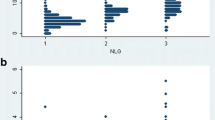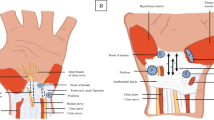Abstract
Objective
To study MRI criteria for diagnosing and predicting severity of carpal tunnel syndrome (CTS).
Methods
Sixty-nine wrists in 41 symptomatic CTS patients and 32 wrists in 28 asymptomatic subjects were evaluated by MRI. Circumferential surface area (CSA), flattening ratio, relative median nerve signal intensity, and retinacular bowing were measured. CTS severity was classified as mild, moderate, or severe. Parameters for patients with and without CTS and for the three severity groups were compared. ROC curves were plotted to assess accuracy for CTS diagnosis and severity prediction.
Results
Significant differences were found between CTS and control wrists for median nerve CSA, flattening ratio at inlet, relative median nerve signal intensity, and retinacular bowing. ROC curve analysis revealed a sensitivity, specificity, and accuracy of median nerve CSA > 15 mm2 proximal to the tunnel (CSAp) of 85.5, 100, and 90.1%. Using either CSAp or CSAd > 15 mm2 as a diagnostic criterion, MRI could achieve a sensitivity of 100% and specificity of 94% for diagnosis of CTS while overall accuracy was 98%.
Significant differences were found among the three severity groups. Sensitivity, specificity, and accuracy of prediction of severe CTS using for CSAp > 19 mm2 were 75.0, 65.9, and 69.6%, respectively.
Conclusions
MRI is highly accurate at diagnosing CTS and moderately accurate at determining CTS severity. We recommend using CSA > 15 mm2 either proximal to or distal to the tunnel as a diagnostic criterion for CTS and CSA > 19 mm2 proximal to the tunnel as a marker for severe CTS.




Similar content being viewed by others
References
Klauser AS, Halpern EJ, De Zordo T, Feuchtner GM, Arora R, Gruber J, et al. Carpal tunnel syndrome assessment with US: value of additional cross-sectional area measurements of the median nerve in patients versus healthy volunteers. Radiology. 2009;250(1):171–7.
Tadjerbashi K, Åkesson A, Atroshi I. Incidence of referred carpal tunnel syndrome and carpal tunnel release surgery in the general population: increase over time and regional variations. J Orthop Surg (Hong Kong). 2019;27(1):1–5.
Oge HK, Acu B, Gucer T, Yanik T, Savlarli S, Firat MM. Quantitative MRI analysis of idiopathic carpal tunnel syndrome. Turk Neurosurg. 2012;22(6):763–8.
Pasternack II, Malmivaara A, Tervahartiala P, Forsberg H, Vehmas T. Magnetic resonance imaging findings in respect to carpal tunnel syndrome. Scand J Work Environ Health. 2003;29(3):189–96.
Jarvik JG, Kliot M, Maravilla KR. MR nerve imaging of the wrist and hand. Hand Clin. 2000;16(1):13–24.
Somay G, Somay H, Cevik D, Sungur F, Berkman Z. The pressure angle of the median nerve as a new magnetic resonance imaging parameter for the evaluation of carpal tunnel. Clin Neurol Neurosurg 2009;111(1):28–33.
Radack DM, Schweitzer ME, Taras J. Carpal tunnel syndrome: are the MR findings a result of population selection bias? AJR. 1997;169(6):1649–53.
Tsujii M, Hirata H, Morita A, Uchida A. Palmar bowing of the flexor retinaculum on wrist MRI correlates with subjective reports of pain in carpal tunnel syndrome. J Magn Reson Imaging. 2009;29(5):1102–5.
Allmann KH, Horch R, Uhl M, Gufler H, Altehoefer C, Stark GB, et al. MR imaging of the carpal tunnel. Eur J Radiol. 1997;25(2):141–5.
Cha JG, Han JK, Im SB, Kang SJ. Median nerve T2 assessment in the wrist joints: preliminary study in patients with carpal tunnel syndrome and healthy volunteers. J Magn Reson Imaging. 2014;40(4):789–95.
Kleindienst A, Hamm B, Lanksch WR. Carpal tunnel syndrome: staging of median nerve compression by MR imaging. J Magn Reson Imaging. 1998;8(5):1119–25.
Aboonq MS. Pathophysiology of carpal tunnel syndrome. Neurosciences (Riyadh). 2015;20(1):4–9.
Lundborg G, Gelberman RH, Minteer-Convery M, Lee YF, Hargens AR. Median nerve compression in the carpal tunnel--functional response to experimentally induced controlled pressure. J Hand Surg Am. 1982;7(3):252–9.
Rempel D, Evan off B, Amadio PC, de Krom M, Franklin G, Franzblau A, et al. Consensus criteria for the classification of carpal tunnel syndrome in epidemiologic studies. Am J Public Health. 1998;88:1447–51.
Mackinnon SE. Pathophysiology of nerve compression. Hand Clin. 2002;18(2):231–41.
Padua L, Padua R, Aprile I, D’Amico P, Tonali P. Carpal tunnel syndrome: relationship between clinical and patient-oriented assessment. Clin Orthop Relat Res. 2002;395:128–34.
Wright SA, Liggett N. Nerve conduction studies as a routine diagnostic aid in carpal tunnel syndrome. Rheumatology (Oxford). 2003;42(4):602–3.
Jablecki CK, Andary MT, So YT, Wilkins DE, Williams FH. Literature review of the usefulness of nerve conduction studies and electromyography for the evaluation of patients with carpal tunnel syndrome. AAEM quality assurance committee. Muscle Nerve. 1993;16(12):1392–414.
Jarvik JG, Yuen E, Kliot M. Diagnosis of carpal tunnel syndrome: electrodiagnostic and MR imaging evaluation. Neuroimaging Clin N Am. 2004;14(1):93–102.
Ng AWH, Griffith JF, Lee RKL, Tse WL, Wong CWY, Ho PC. Ultrasound carpal tunnel syndrome: additional criteria for diagnosis. Clin Radiol. 2018;73(2):214.
Lee RKL, Griffith JF, Ng AWH, et al. Cross-sectional area of the median nerve at the wrist: comparison of sonographic, MRI, and cadaveric measurements. J Clin Ultrasound. 2019;47(3):122–7.
Britz GW, Haynor DR, Kuntz C, Goodkin R, Gitter A, Kliot M. Carpal tunnel syndrome: correlation of magnetic resonance imaging, clinical, electrodiagnostic, and intraoperative findings. Neurosurgery. 1995;37(6):1097–103.
Cudlip SA, Howe FA, Clifton A, Schwartz MS, Bell BA. Magnetic resonance neurography studies of the median nerve before and after carpal tunnel decompression. J Neurosurg. 2002;96(6):1046–51.
Cohen J. A coefficient of agreement for nominal scales. Educ Psych Meas. 1960;20:37–46.
El Miedany YM, Aty SA, Ashour S. Ultrasonography versus nerve conduction study in patients with carpal tunnel syndrome: substantive or complementary tests? Rheumatology (Oxford) 2004;43(7):887–895.
Altinok T, Baysal O, Karakas HM, Sigirci A, Alkan A, Kayhan A, et al. Ultrasonographic assessment of mild and moderate idiopathic carpal tunnel syndrome. Clin Radiol. 2004;59(10):916–25.
Keberle M, Jenett M, Kenn W, Reiners K, Peter M, Haerten R, et al. Technical advances in ultrasound and MR imaging of carpal tunnel syndrome. Eur Radiol. 2000;10(7):1043–50.
Sarria L, Cabada T, Cozcolluela R, Martínez-Berganza T, García S. Carpal tunnel syndrome: usefulness of sonography. Eur Radiol. 2000;10(12):1920–5.
Duncan I, Sullivan P, Lomas F. Sonography in the diagnosis of carpal tunnel syndrome. AJR. 1999;173(3):681–4.
Dailey AT, Tsuruda JS, Filler AG, Maravilla KR, Goodkin R, Kliot M. Magnetic resonance neurography of peripheral nerve degeneration and regeneration. Lancet. 1997;350(9086):1221–2.
Teresi LM, Hovda D, Seeley AB, Nitta K, Lufkin RB. MR imaging of experimental demyelination. AJR. 1989;152(6):1291–8.
Horch RE, Allmann KH, Laubenberger J, Langer M, Stark GB. Median nerve compression can be detected by magnetic resonance imaging of the carpal tunnel. Neurosurgery. 1997;41(1):76–82.
Chammas M, Boretto J, Burmann LM, Ramos RM, Dos Santos Neto FC, Silva JB. Carpal tunnel syndrome - part I (anatomy, physiology, etiology and diagnosis). Rev Bras Ortop. 2014;49(5):429–36.
Brahme SK, Hodler J, Braun RM, Sebrechts C, Jackson W, Resnick D. Dynamic MR imaging of carpal tunnel syndrome. Skelet Radiol. 1997;26(8):482–7.
Sernik RA, Abicalaf CA, Pimentel BF, Braga-Baiak A, Braga L, Cerri GG. Ultrasound features of carpal tunnel syndrome: a prospective case-control study. Skelet Radiol. 2008;37(1):49–53.
Wong SM, Griffith JF, Hui AC, Tang A, Wong KS. Discriminatory sonographic criteria for the diagnosis of carpal tunnel syndrome. Arthritis Rheum. 2002;46(7):1914–21.
Rempel D, Bach JM, Gordon L, So Y. Effects of forearm pronation/supination on carpal tunnel pressure. J Hand Surg Am. 1998;23(1):38–42.
Acknowledgements
The work described in this paper was partially supported by a grant from the Research Grants Council of the Hong Kong Special Administrative Region, China (Project No.SEG_CUHK02). Special thanks to Jason Leung, CUHK statistician, for his help with this manuscript.
Author information
Authors and Affiliations
Corresponding author
Ethics declarations
Ethical approval
All procedures performed in this study were in accordance with the ethical standards of our institutional research committee and with the 1964 Helsinki Declaration and its later amendments or comparable ethical standards. Written informed consent was obtained from all individual participants included in the study.
Conflict of interest
There are no conflicts of interest for any of the authors.
Additional information
Publisher’s note
Springer Nature remains neutral with regard to jurisdictional claims in published maps and institutional affiliations.
Rights and permissions
About this article
Cite this article
Ng, A.W.H., Griffith, J.F., Tong, C.S.L. et al. MRI criteria for diagnosis and predicting severity of carpal tunnel syndrome. Skeletal Radiol 49, 397–405 (2020). https://doi.org/10.1007/s00256-019-03291-0
Received:
Revised:
Accepted:
Published:
Issue Date:
DOI: https://doi.org/10.1007/s00256-019-03291-0




